What is the Anatomy of a Roof System?
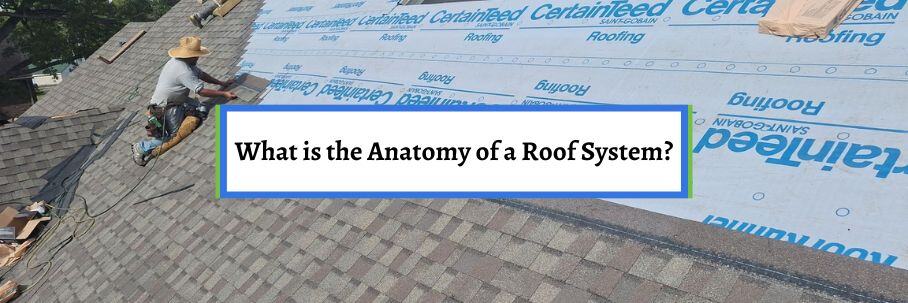
Need a new roof? Are you trying to figure out what exactly gets replaced, installed, and, most importantly, what you’re paying for?
This is understandable, especially considering a roof isn’t just the top layer you see from the ground. In fact, the anatomy of a roof system is a combination of multiple materials and components that each have a specific purpose.
So, what is the anatomy of a roof system? And what do you need to know about each piece of the puzzle?
At Bill Ragan Roofing, we use our 30-plus years of roofing experience to help homeowners like you understand everything that goes into a roof system. And nothing is more important than knowing the things that actually make a roof a roof.
Just know this article won’t cover the general construction aspect of a roof and home, like rafters or trusses. Instead, I’ll break down the materials that make up the anatomy of a roof system, so you know what to expect when getting a new roof.
Roof decking
Roof decking (also called roof sheathing) is the wooden foundation (plywood or planks) and the first official roof layer. Your roof will have one of two types: plank or sheet decking.
Plank decking is made of 1x6 or 1x8 rectangular wooden boards, depending on the span of your rafters. Sheet decking (or sheathing) is made of flat sheets of wood that cover more area than planks.
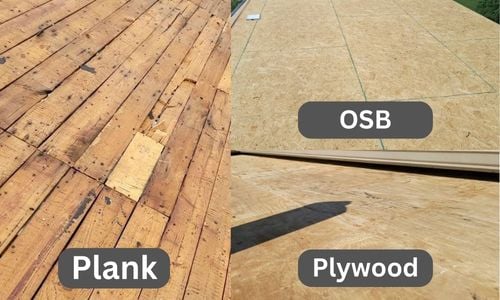
There are two types of sheet decking: OSB and plywood. OSB (oriented strand board) consists of wood chips/strips compressed together to form a flat 7/16” sheet, while plywood comes in several different thicknesses (⅜”, ½”, ⅝”, and ¾”).
Just know that any rotten or compromised roof decking must be replaced before installation begins. Also, if plank decking has more than a 1/8” between the planks, it must be replaced per the shingle manufacturer’s installation instructions.
While they’ll have a good idea if any decking needs replacing, a roofer won’t know how much until after tearing off your old roof.
Drip edge
Drip edge is metal flashing installed at the roof’s edges (eaves and rakes) to prevent water from getting underneath the roofing material and going behind your gutters. It’s such an important piece of a roof’s anatomy that it’s actually required per building codes and must be installed correctly.
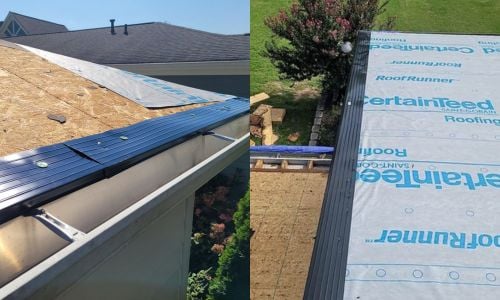
Not only will your home fail an inspection without it, but your fascia board and roof decking’s edges will rot from prolonged exposure to water. So, its importance can’t be overstated.
Unfortunately, there are too many roofs without drip edge. It can be left off by laziness or lack of experience, but bad roofers knowingly exclude it from their estimates to lower prices.
Underlayment
Roof underlayment is a felt or synthetic material installed directly over the roof decking to provide a layer of protection if water gets underneath the main roofing material. There are two types of underlayment: felt and synthetic.
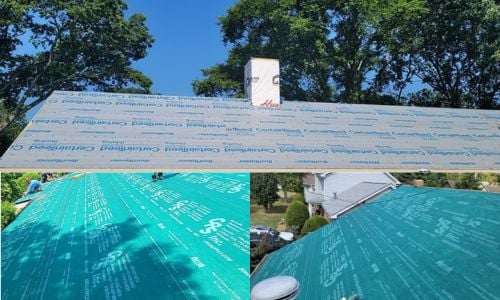
Felt underlayment comes in 15 lb and 30 lb rolls, with the 30 lb option being thicker, stronger, and less likely to tear than 15 lb. Synthetic underlayment is made out of woven/spun polyethylene or polypropylene that wicks water and doesn’t hold moisture.
It’s more durable, holds nails better, and repels water much better than felt underlayment. So, I recommend spending the extra money on the functionality and better water protection synthetic underlayment offers.
Ice and water shield
Like underlayment, ice and water shield is a waterproof membrane that protects your roof decking from water if it gets under the roofing material. However, it’s only installed on/around certain problem areas that need added protection instead of over the entire roof deck.
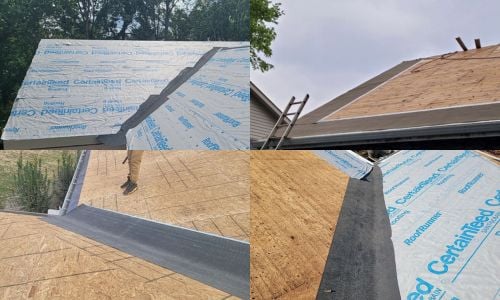
Ice and water shield is mainly installed in roof valleys, around penetrations, against walls, and on roof pitches below a 4/12. Just know that certain areas above the snowline in the US also require two rows along the edges of your roof per building codes to prevent frequent ice dam leaks.
However, this is considered an upgrade in places like our area of Middle Tennessee.
Roof flashing
Roof flashing is a metal material that directs water away and prevents it from getting behind areas (walls, chimneys, roof valleys) where the roofing material butts up against something. Roofs that don’t have flashing in these areas will experience significant leaks, which makes it one of the most crucial materials.
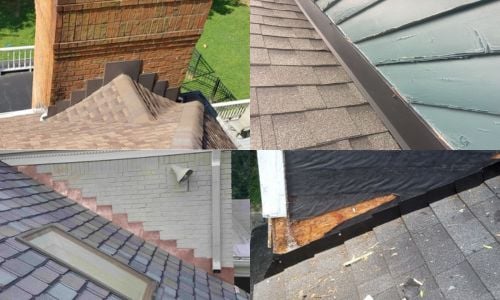
You can choose any metal type, but aluminum, steel, and copper are the most commonly used on roofs. Steel is the most popular choice for residential roofing due to its durability and affordability.
But if you want an upgraded look and more curb appeal, copper is well worth the investment if you have the budget. While roof flashing usually outlives the other components, I always recommend replacing it when getting a new roof.
Starter shingles
Starter shingles are a pre-cut row of roofing material that goes underneath the first course of shingles before they’re installed. It makes sure that there's protection between the joints where the shingles butt against each other on the edges of your roof.
Starter shingles also have an adhesive to ensure the first row of shingles is sealed at the roof edges for resistance to strong winds. Just keep in mind that this explanation is specific to asphalt shingles, but every roofing material has some kind of starter row of shingles.
Roofing material
Your roofing material is the top layer you see from the ground that makes up the bulk of the roof system. The most popular residential roofing materials are asphalt shingles, standing seam metal roofing, cedar shake roofing, synthetic roofing, and slate roofing.
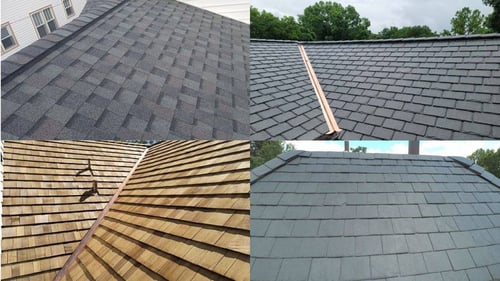
The one you choose greatly impacts your new roof's cost, aesthetic, lifespan, and warranty options. That’s why it’s important to do the research to pick the right one for you and your budget.
Ridge capping
Ridge capping is installed where two roof slopes meet to seal a roof system at the highest points. It will be an accessory of the main roofing material pre-bent to form perfectly on a roof’s ridge.

No matter which material you choose, every roof needs the associated ridge capping. Unfortunately, some roofers avoid using proper ridge capping to keep their costs low.
This is especially common for asphalt shingles, with some roofers installing 3-tab shingles at the ridge instead of a manufacturer's ridge capping on architectural shingle roof systems. This may keep costs down, but it will lead to a roof leak because they’re not meant to be bent and used this way.
Roof vents
Roof vents allow your attic and home to breathe properly by pulling fresh air through intake vents and pushing out trapped air through exhaust vents. There are multiple roof vent options, but it depends on the type of ventilation system (active and passive) you have or want.
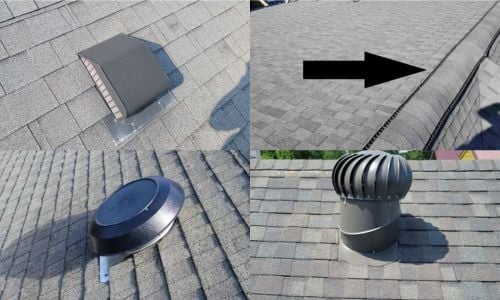
The most common options for an active ventilation system are turbine vents, power vents, ridge vents with a baffle, or solar-powered vents. For a passive ventilation system, the most common types are static vents (box vents), ridge vents without a baffle, or a gable-end vent.
Just keep in mind that certain vents are better for certain roof styles, so it’s important to discuss the options with your roofing contractor. However, I always recommend an active ventilation system for performance reasons.
Pipe boots
A pipe boot (also called roof boot) goes around the base of the pipes and other small penetrations coming through your roof. They prevent water from following the sides of pipes down into your attic and home.

Depending on the roofing material and type of pipe, pipe boots can be synthetic rubber, plastic, lead, copper, etc. However, the most common type used on residential roofs today is a synthetic rubber called neoprene.
Just know that neoprene pipe boots will need replacing every 10 years or so once cracks form to avoid leaks. However, they’ll be cheaper than copper (or another metal), more durable than plastic, and won’t attract animals like lead.
What should you consider before getting a new roof?
Now you know the anatomy of a roof system, what every layer does, and the different options for each. At the end of the day, every single component must be part of your roof system to avoid costly problems.
However, this is just the beginning of what you need to know before getting a new roof. A roof replacement is a large and expensive home improvement project but also complex.
Trust me, the last thing you want is to be taken advantage of by a bad roofer or make the wrong decisions. That’s why I wrote another article breaking down the things every homeowner needs to consider before getting a new roof.
Check out 7 Things to Consider Before a Roof Replacement so you go into the process with the right mindset and information needed to get the best roof possible.


